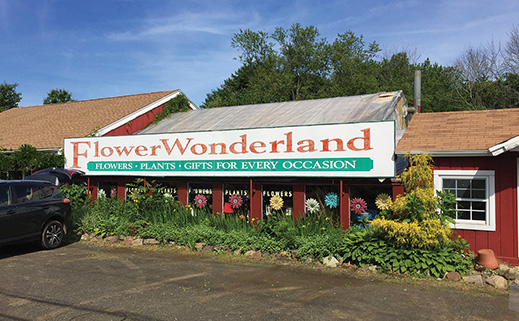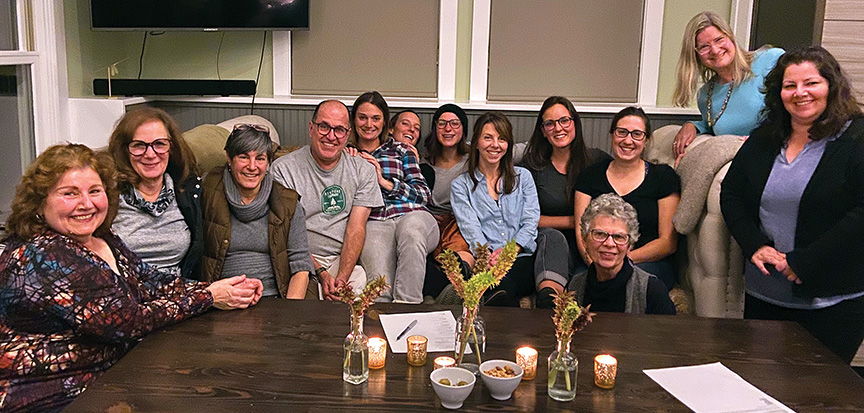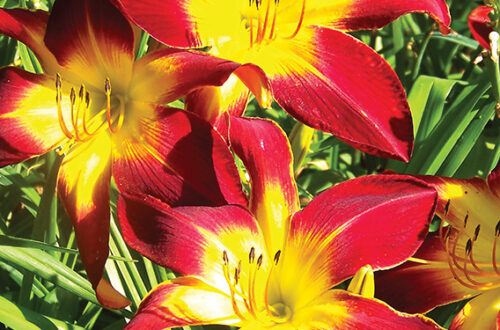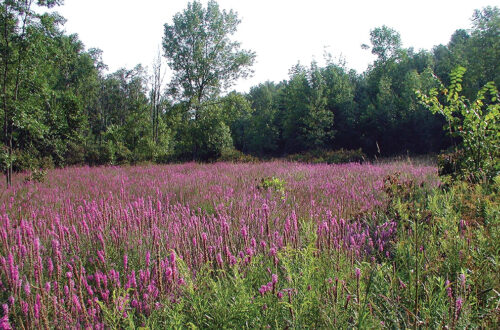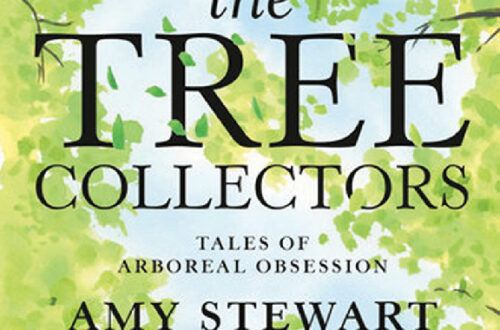By Anne Rowlands
EARLY LAST YEAR Michael Russo contacted me about the new Branford-based Connecticut Flower Collective (CFC). Michael – a CG contributor, floral designer and flower farmer at Trout Lily Farm – wrote, “This is so new, exciting and happening for the Connecticut floral scene … It will be a bit bumpy and a diamond in the rough to start, but I believe a progressive and forward thinking concept for the Connecticut floral community.”
The concept had been tossed around for several years among a core group of flower farmers who decided to make it a reality. They knew there were plenty of floral designers wanting local materials, and that a fixed location would ease the burden of long deliveries.
Prior to the convenience of one-stop shopping on market days, individual farms sold direct to designers. It’s great for the farmers to have orders to fill, but packing up and driving all over the state to make deliveries is punishing, especially with young children. On the buyer side of the equation, orders must often be sourced from several farms. That adds up to a lot of deliveries, and the collective was the perfect solution.
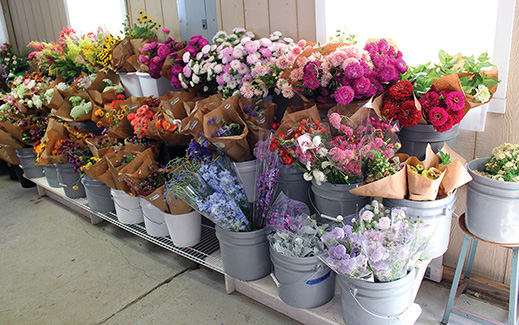
Much like a members-only farmer’s market, CFC is organized as a local, wholesale cut flower market offering a local, sustainable product. A collective isn’t an official entity – but it needs a business tax ID to run sales through, and a location.
Happily, a central location was found when Gigi Fusco, owner of Flower Wonderland in Branford, offered 357 sq. ft. of former greenhouse space. Choosing not to compete with Gigi, the group agreed that the market would only be open to wholesale buyers; the general public can always buy from the individual farms – just not at the market.
The tiny space in Branford has no room for separate booths, so materials from each farm are displayed together and labeled, allowing buyers to spread their dollars around.
Market day is once weekly from May through October, with two holiday markets late in the year. Branford was selected for convenience in 2019, but in the future they expect to expand distribution points.
The Farmers & Collective Staff
There are several core members of the group. Kate Brunson of Maple & Mum in Branford is the market manager and a founding member along with Evelyn Lee (Butternut Gardens, Southport), Haley Billip (Eddy Farm, Newington), Michael Russo (Trout Lily Farm, Guilford) and Elise Cusano
(Four Root Farm, East Haddam).
Despite the experimental nature of the endeavor, everyone’s really pleased with the way things are working out. Using existing collectives in Michigan, Colorado, North Carolina, and the Pacific Northwest as models, there’s been no need to reinvent the wheel.
A sense of community quickly formed among the group, and they find themselves looking forward to each market day and the prospect of taking a few precious hours to socialize and exchange information.
Slow Flowers vs. Traditional
After listening to Debra Prinzing’s Slow Flower podcasts, market manager Kate Brunson was inspired to become a designer focused on local sourcing. If you haven’t heard of the Slow Flowers movement or Debra Prinzing, you’ll find it’s based on the same philosophy as the Slow Food movement: know where your food comes from (or, in this case, your flowers) and who’s doing the growing.
Traditional wholesale floral material in the U.S. arrives in boxes, 80% of which is imported. As a rule, the material’s doused in chemicals and wrapped in a whole lot of packaging. When flowers are imported, U.S. Customs often fumigates to prevent insect hitchhikers from making it on to our shores but, in some cases, depending on what country or region the flowers are coming from, everything is sprayed – no exceptions. Think about that when you next bury your nose in a bouquet.
Most CFC farmers grow on less than two acres and avoid chemicals. It can be argued that the quality of traditionally available wholesale flowers is nowhere near as good as freshly grown, locally available alternatives, making both growers and designers feel much better about the practices used to raise them.
Flowers also happen to be a very profitable crop, giving a boost to the local economy.
The Product
From ageratum to zinnias, each week the market has its highlights. Flowering branches, edibles, foliage, vines, grasses, grains, herbs – anything is possible. I watched as old familiars were carried in along with crabapple branches, grasses, ninebark, cress, peonies, snapdragons, penstemon, bishop’s weed, philadelphus, feverfew, nigella, green tomatoes on the vine, pokeweed, and (my favorite) “a weed from my mother-in-law’s garden.”
June’s top sellers were ranunculus, tulip, peony, stock, zinnia, dahlia, and lisianthus, most of which don’t ship well, so are in high demand.
Different farms come to the fore at different times of year, depending on what’s planted, the harvest, the weather, and any insect or disease pressure; and there’s plenty of experience in this group, with some farming flowers for more than 20 years.
On Fridays, farmers let Kate know what’s available for pre-order. An email list goes out, and orders are due by Monday. Some growers only offer pre-order, some only bring material to market, some do both. Quite simply, pre-ordering makes life much easier for everyone, and pre-ordering members often make additional purchases when picking up their orders.
Interestingly, for events, plant material only needs to look good for 6 hours, so buying as fresh as possible makes a lot of sense (and if you think “what a waste!” see what What Cheer Farm in Rhode Island is doing with “used” flowers at whatcheerfarm.org).
The Buyers
Member buyers include a home stager, studio florists, floral and interior designers, a flower shop, grocer, restaurant, artist/photographer, and flower farmers (many are professional floral designers themselves), so materials might end up anywhere – a wedding, fundraiser, dinner party, memorial service, or even on a magazine cover.
Ellen Hoverkamp, who created our stunning cover, went to the market all season long. Free of major work obligations for a few months, she splurged on weekly bouquets and documented the whole market season in her botanical photographs (some are below).
Michael Russo also attended most every market, both as farmer and designer, taking advantage of the often unexpected materials to be found. Pre-orders are great, but designers need to see their material. “You can see how people bring their palettes in their heads,” Ellen said, pointing out how each buyer selects, combines, and muses over choices. When a particular flower caught Michael’s eye, photos were snapped, texts exchanged, and permission was sought to add the flower purchase to a client’s budget.
Although many CFC members were already purchasing from local farms, the market better serves the designers by letting them pre-order to get exactly what they need; and for those who are really advance planners, custom orders for next season’s plantings can be made.
How It Works
On Wednesday, sellers set up at 9 am, and the market’s open from 10 until noon. Sales are directed through Eddy Farm and farms are paid each month. Each farm pays a fee to cover costs associated with running CFC, such as space rental and salaries to management.
To join the collective, you register on the website. Every member pays an annual fee to sell, buy, or do both. Members can access CFC’s availability list and email distribution list. Walk-in registrations can be accommodated – one can join on the spot. If you’re interested, just remember it’s a wholesale operation. Anyone without the requisite tax ID who wants to buy some beautiful, locally grown fresh flowers is encouraged to contact farmers directly – the list is on their website, ctflowercollective.com. Quite a few member farmers do direct-to-consumer sales (think farmers markets) and similar events where they’re open to the public.
CFC now boasts 24 farmer/florist members and 29 floral designer/flower shop members, a strong start for this new organization that’s sure to increase as word gets out.
Michael Russo was spot on – this diamond in the rough is indeed starting to sparkle, and in 2020 The Connecticut Flower Collective will bring further convenience to members and lots of beauty to the rest of us.
Connecticut Flower Collective
Flower Wonderland, 776 East Main St., Branford
• Wednesdays, May-October, 10-noon
• Two holiday-season markets
• Market open to members only (must have tax ID to join)
• ctflowercollective.com lists all farmer members – non-members can contact farms directly to purchase.
